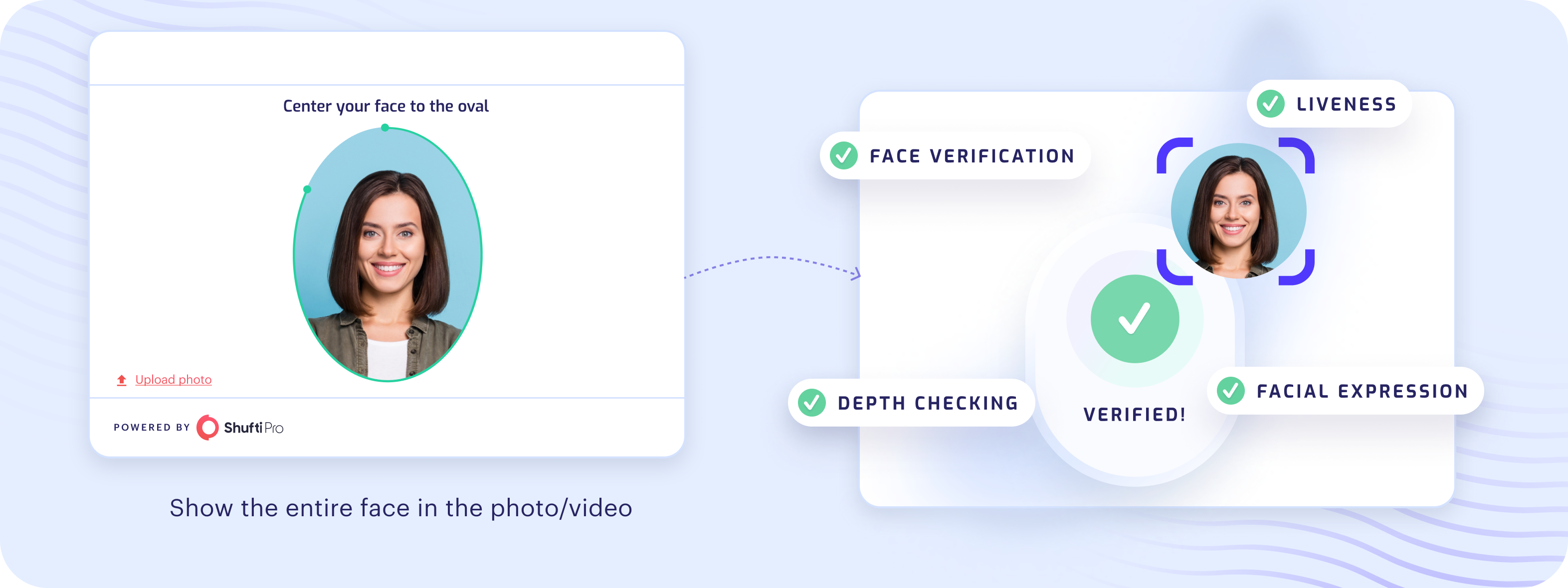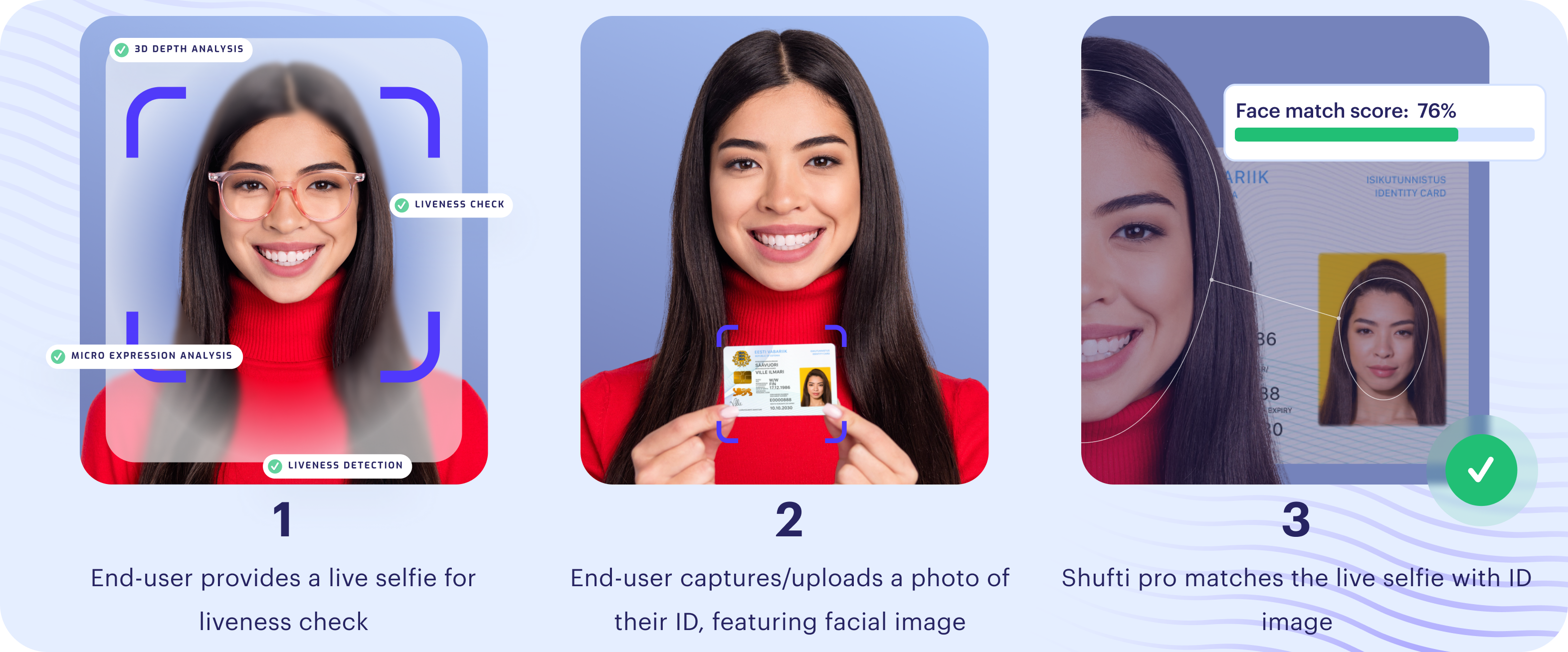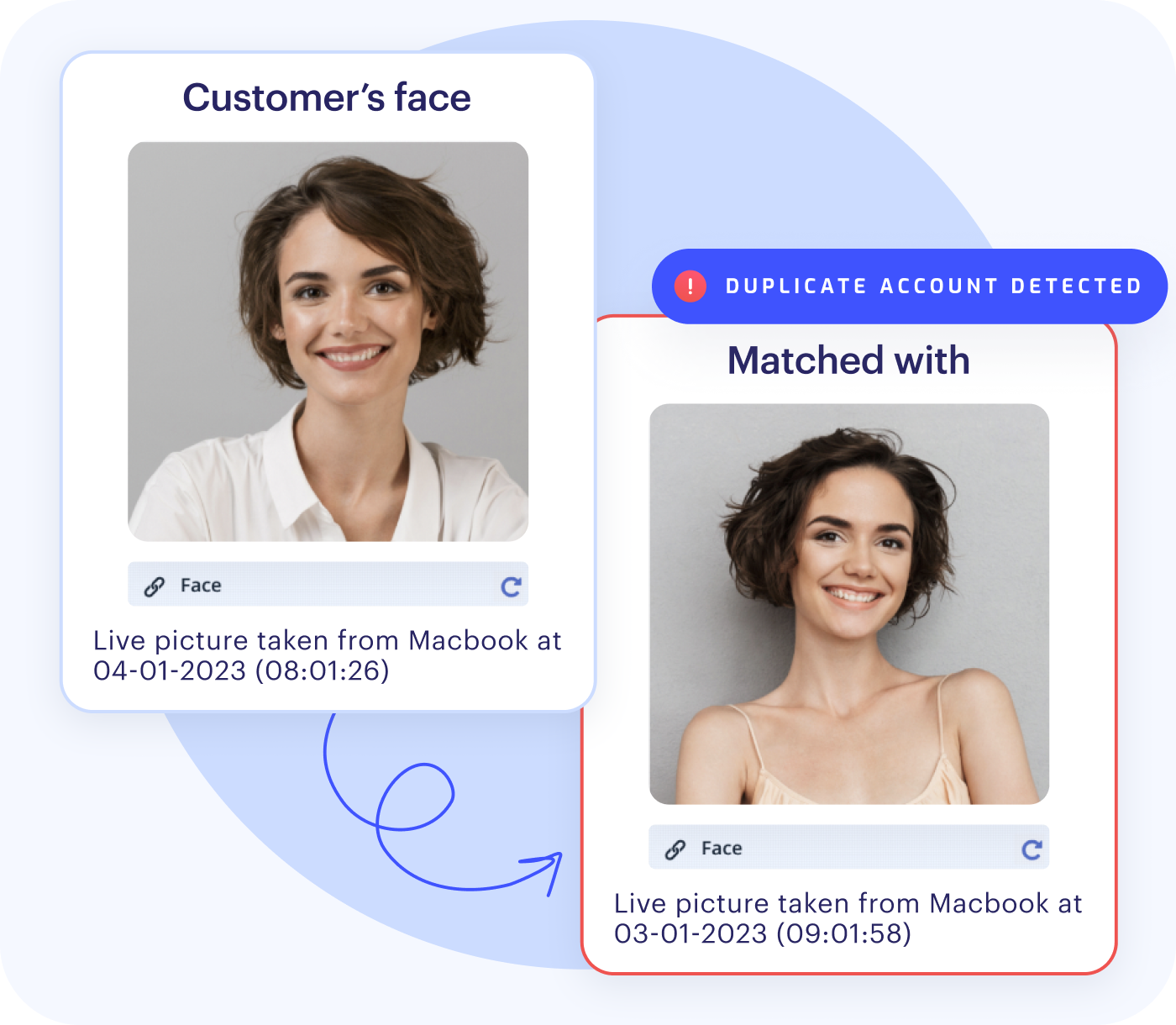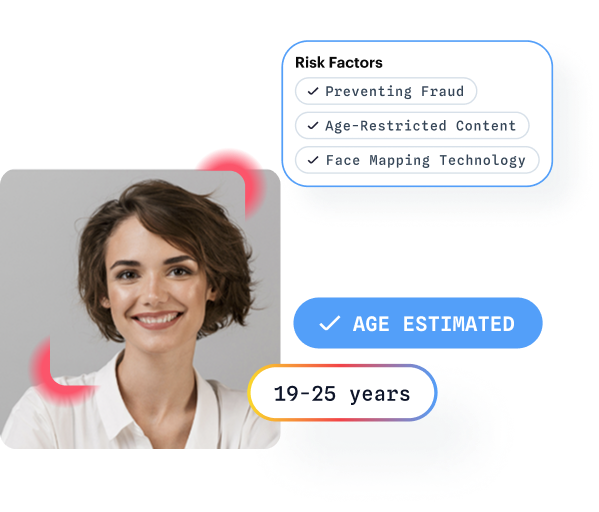How It Works?
AI-powered biometric technology that identifies individuals by comparing and analyzing end user facial features. Implement Shufti's liveness verification solution to confirm the presence of an actual person in front of the camera. This solution performs a comprehensive 3D depth analysis of the end user's facial features, effectively identifying potential risks such as face mask attacks, deep fakes, AI-generated face images, static face images, and other similar threats. This ensures enhanced security and authenticity in end user verification processes. Shufti’s facial biometric verification can be used independently or with other KYC services according to client requirements.
The end user aligns their face in front of the device's camera, following prompts to perform subtle facial gestures and movements as instructed. These actions are crucial for completing the verification process, ensuring that the user's identity is accurately confirmed through real-time biometric analysis.
Steps for Face verification
- User initiates verification by facing the camera for real-time liveness confirmation.
- System auto-captures the best frame for optimal biometric analysis.
- Verification concludes, ensuring secure and accurate identity confirmation.

Facial biometric service can also be used with document verification to match the face of an end user with the face image on the document.
Steps for Face verification with Document
- The end user captures or uploads a photo of their ID document, which prominently features their facial image.
- End user provides a live selfie through their device for real-time liveness confirmation.
- Shufti matches the user's live selfie with the image on the ID document for biometric analysis.
- Verification concludes, ensuring secure and accurate identity confirmation of the end user.

Duplicate Account Detection:
Shufti offers a robust Duplicate Account Detection feature designed to identify and prevent multiple registrations from the same account. This advanced functionality is instrumental in verifying the identity of new users while acting as a deterrent against fraud.

Parameter for Duplicate Account Detection
| Parameters | Description |
|---|---|
| check_duplicate_request | Required: No Type: string Accepted value: 0 & 1 Default value: 0 This parameter is used to enable the duplicate account detection service. Face mapping technology identify duplicate faces across all customers through which duplicate accounts are detected. The duplicate account detection will be disabled if the value is 0 and enabled if the value is 1. |
{
"face" : {
"proof" : "",
"allow_offline" : "1",
"allow_online" : "1",
"verification_mode": "any",
"check_duplicate_request" : "1"
}
}
Verification Data Parameters
The following parameters are verified in the case of verification accepted or declined
| Parameters | Description |
|---|---|
| duplicate_account_detected | This key object contains information about the duplication status. It can be either true (duplication detected), false (no duplication), or null (invalid picture). |
Facial Age Estimation
Shufti provides an advanced Facial Age Estimation feature that uses cutting-edge facial biometrics technology to estimate a user’s age based on their facial features. This feature helps businesses enhance customer onboarding, enforce age-restricted access, and meet regulatory compliance requirements with high accuracy.
The age estimation works by analyzing the user's facial features and predicting an estimated age range. The estimated range includes a buffer of ±3 years to account for natural variations in facial features and to increase the accuracy of the result. For example, if the system estimates the age to be 25, the reported range will be 22 to 28.
This feature can be configured directly from the Shufti Back Office or integrated into your workflow using Shufti's API. When enabled, the system will analyze the user's face and return an estimated age range in the response. If age estimation is not required, you can disable it or omit the relevant fields in the API request.

How it works:
Create Verification Link
- The client creates a verification link by enabling Facial Biometrics and Age Estimation with an optional age range.
Initiate Face Verification
- The user starts face verification and captures or uploads their live face image.
Age Estimation
- Shufti performs a liveness check and extracts the estimated age from facial features.
View Results
- The estimated age range is shown in the report (if no range is specified).
- If an age range is specified, the report will display:
- Exact Match – If the estimated age range falls within the specified range.
- Partial Match – If the estimated age range partially overlaps the specified range.
- No Match – If the estimated age range falls outside the specified range.
If the liveness check fails, the age estimation will not be performed.
Parameters and Description
| Parameters | Description |
|---|---|
| age | Required: No Type: Object If the age object is passed, the system will estimate the user’s age based on facial features. If no min or max value is specified, the system will still return an estimated age range with a ±3 year buffer. |
| age.min | Required: No Type: Integer Set the minimum acceptable age for verification. The value must be between 1 and 170. It cannot be equal to the max value. |
| age.max | Required: No Type: Integer Set the maximum acceptable age for verification. The value must be between 1 and 170. It cannot be equal to the min value. |
Facial Age Estimation Sample Object
Sample Request Payload
{
"face": {
"proof": "",
"age" : {
"min" : "",
"max" : ""
}
}
}
Sample Response Payload
Previously, the face key in the verification_result was represented as an integer:
{
"verification_result": {
"face": 1
}
}
When age parameter is used in face service, the face key has been converted from an integer to an object. It now contains multiple attributes, such as face and age:
{
"verification_result": {
"face": {
"face": 1,
"age": 1
}
}
}
This change allows for more detailed information within the face key, enabling the inclusion of additional parameters related to facial verification.